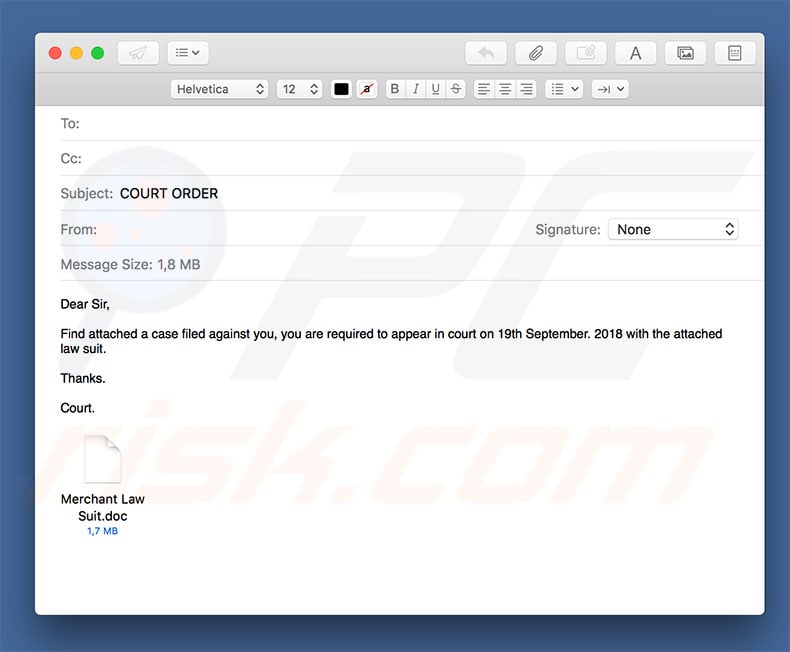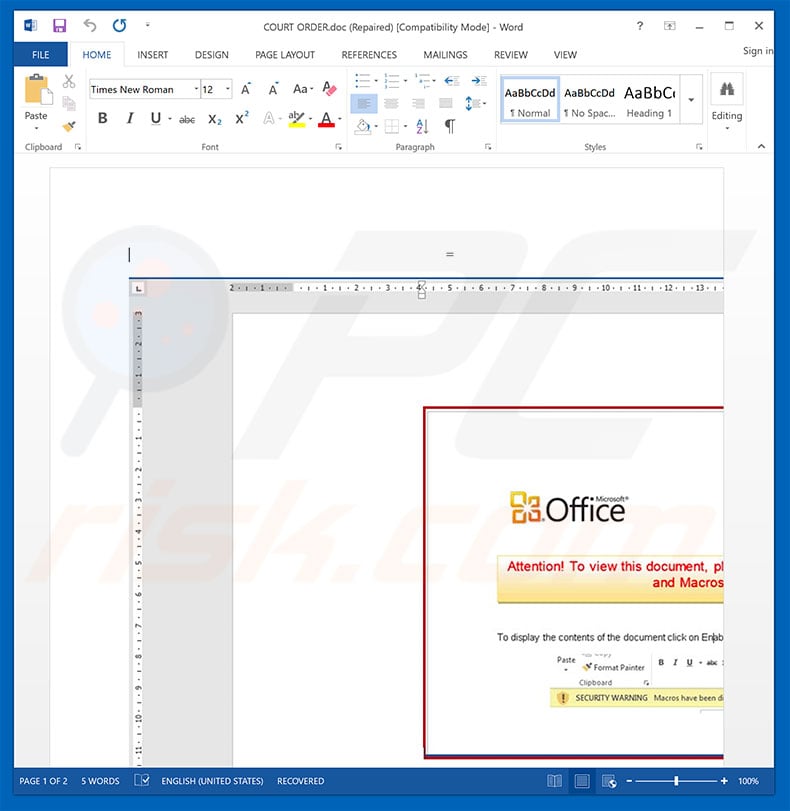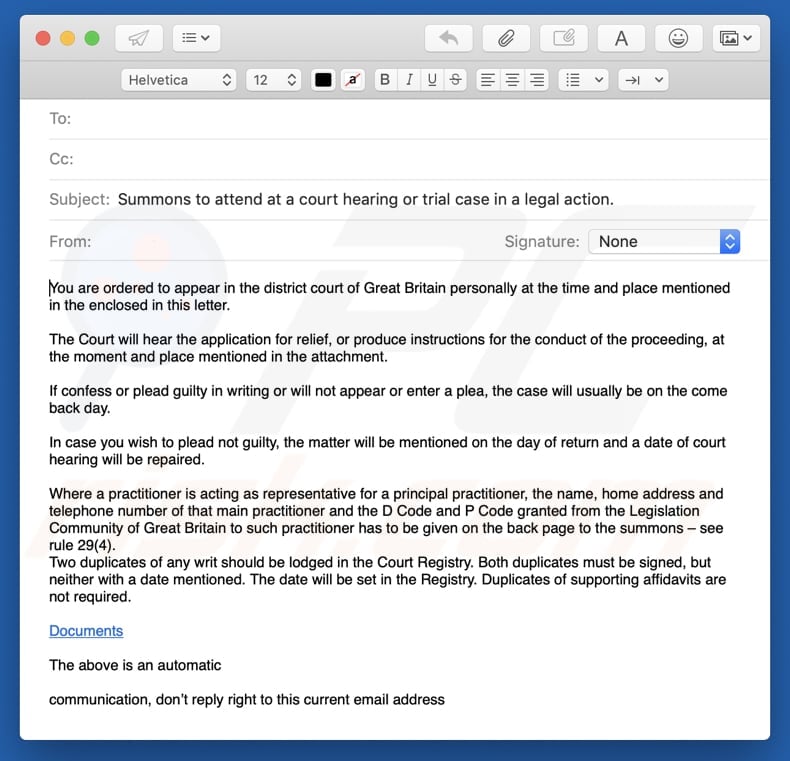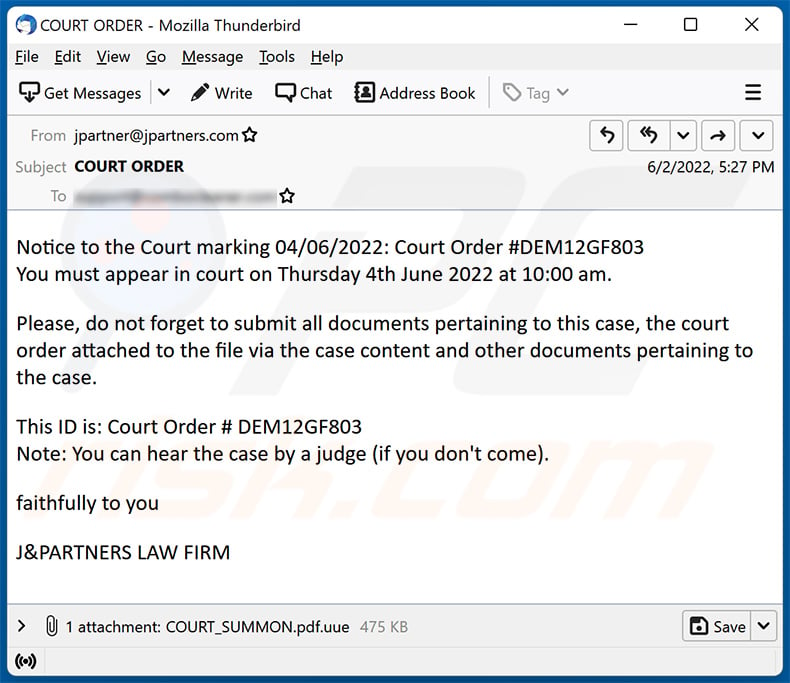Get free scan and check if your device is infected.
Remove it nowTo use full-featured product, you have to purchase a license for Combo Cleaner. Seven days free trial available. Combo Cleaner is owned and operated by RCS LT, the parent company of PCRisk.com.
What is Court Order Email Virus?
Similar to "Invoice Attached - FINAL NOTICE Email Virus", "DHL Express Email Virus", and many others, "Court Order Email Virus" is a spam email campaign used to proliferate a high-risk trojan called Trojan:Win32/Sonbokli. Developers send thousands of deceptive emails encouraging users to open attached malicious Microsoft Office documents that infiltrate Trojan:Win32/Sonbokli into the system.

"Court Order Email Virus" campaign emails are presented as court orders stating that a case has been filled against the user and encouraging her/him to open the attached document for more information. Opening the file results in infiltration of the Trojan:Win32/Sonbokli trojan.
Cyber criminals often hide behind names of popular companies and governmental institutions simply to increase the number of infections. Users are much more likely to open documents when they are received from suspicious emails. Trojans like Trojan:Win32/Sonbokli typically do several things: record various information; proliferate other viruses; connect infected systems to botnets, and; mine cryptocurrencies.
These viruses usually target logins/passwords, which they record and send to remote servers controlled by cyber criminals. These people might gain access to accounts relating to social networks, banks, and so on. Therefore, the presence of adware-type application such as Court Order Email Virus can lead to serious privacy issues and significant financial loss.
Furthermore, trojans are likely to cause chain infections - one virus distributes another. Once connected to a botnet, the infected computer might be used to connect to networks (remote server attacks), websites, etc. Cryptominers misuse system resources to mine cryptocurrencies without users' consent.
There are dozens of trojan-type viruses distributed using spam email campaigns. Hancitor, Adwind and FormBook are just some examples from many. These viruses may have slightly different behavior (some record data, others proliferate viruses, and son ), however, all pose a direct threat to your privacy and browsing safety. Eliminate them immediately.
How did Court Order Email Virus infect my computer?
The "Court Order Email Virus" campaign distributes a malicious Microsoft Office document that, once opened, asks victims to enable macro commands, however, by doing so, users inadvertently grant set-ups permission to execute commands that download and install the Trojan:Win32/Sonbokli virus.
This malware distribution method is simple and effective, however, it has a major flaw. The malicious attachments are only able to download malware if the user opens them using MS Office software. For example, the .doc file can only infect systems if users open attachments using MS Word software.
How to avoid installation of malware?
To prevent this situation, be very cautious when browsing the Internet. Carefully analyze each email attachment received. Files that are irrelevant and those received from suspicious/unrecognizable email address should never be opened. Keep the operating system up-to-date and use a legitimate anti-virus/anti-spyware suite, since these tools can detect and eliminate malware before it does any damage.
Note that 2010 and newer versions of Microsoft Office open newly-downloaded documents in "Protected View" mode, which prevents malicious attachments from directly executing malicious commands and infecting the system. Using older versions of this software package is risky.
If you have already opened a "Court Order Email Virus" attachment, we recommend running a scan with Combo Cleaner Antivirus for Windows to automatically eliminate infiltrated malware.
Text presented in the "Court Order Email Virus" email message:
Subject: COURT ORDER
Dear Sir,
Find attached a case filed against you, you are required to appear in court on 19th September. 2018 with the attached law suit.
Thanks.
Court.
Malicious attachment distributed via "Court Order Email Virus" spam campaign:

Another variant of fake court order email, this one distributes Ursnif Trojan:

Text presented in this variant:
Subject: Summons to attend at a court hearing or trial case in a legal action.
You are ordered to appear in the district court of Great Britain personally at the time and place mentioned in the enclosed in this letter.
The Court will hear the application for relief, or produce instructions for the conduct of the proceeding, at the moment and place mentioned in the attachment.
If confess or plead guilty in writing or will not appear or enter a plea, the case will usually be on the come back day.
In case you wish to plead not guilty, the matter will be mentioned on the day of return and a date of court hearing will be repaired.
Where a practitioner is acting as representative for a principal practitioner, the name, home address and telephone number of that main practitioner and the D Code and P Code granted from the Legislation Community of Great Britain to such practitioner has to be given on the back page to the summons – see rule 29(4).
Two duplicates of any writ should be lodged in the Court Registry. Both duplicates must be signed, but neither with a date mentioned. The date will be set in the Registry. Duplicates of supporting affidavits are not required.
Documents
The above is an automatic
communication, don’t reply right to this current email address
Example of court order-themed spam email spreading AsyncRAT malware:

Text presented within:
Subject: COURT ORDER
Notice to the Court marking 04/06/2022: Court Order #DEM12GF803
You must appear in court on Thursday 4th June 2022 at 10:00 am.Please, do not forget to submit all documents pertaining to this case, the court order attached to the file via the case content and other documents pertaining to the case.
This ID is: Court Order # DEM12GF803
Note: You can hear the case by a judge (if you don't come).faithfully to you
J&PARTNERS LAW FIRM
Instant automatic malware removal:
Manual threat removal might be a lengthy and complicated process that requires advanced IT skills. Combo Cleaner is a professional automatic malware removal tool that is recommended to get rid of malware. Download it by clicking the button below:
DOWNLOAD Combo CleanerBy downloading any software listed on this website you agree to our Privacy Policy and Terms of Use. To use full-featured product, you have to purchase a license for Combo Cleaner. 7 days free trial available. Combo Cleaner is owned and operated by RCS LT, the parent company of PCRisk.com.
Quick menu:
- What is Court Order spam?
- Types of malicious emails.
- How to spot a malicious email?
- What to do if you fell for an email scam?
Types of malicious emails:
![]() Phishing Emails
Phishing Emails
Most commonly, cybercriminals use deceptive emails to trick Internet users into giving away their sensitive private information, for example, login information for various online services, email accounts, or online banking information.
Such attacks are called phishing. In a phishing attack, cybercriminals usually send an email message with some popular service logo (for example, Microsoft, DHL, Amazon, Netflix), create urgency (wrong shipping address, expired password, etc.), and place a link which they hope their potential victims will click on.
After clicking the link presented in such email message, victims are redirected to a fake website that looks identical or extremely similar to the original one. Victims are then asked to enter their password, credit card details, or some other information that gets stolen by cybercriminals.
![]() Emails with Malicious Attachments
Emails with Malicious Attachments
Another popular attack vector is email spam with malicious attachments that infect users' computers with malware. Malicious attachments usually carry trojans that are capable of stealing passwords, banking information, and other sensitive information.
In such attacks, cybercriminals' main goal is to trick their potential victims into opening an infected email attachment. To achieve this goal, email messages usually talk about recently received invoices, faxes, or voice messages.
If a potential victim falls for the lure and opens the attachment, their computers get infected, and cybercriminals can collect a lot of sensitive information.
While it's a more complicated method to steal personal information (spam filters and antivirus programs usually detect such attempts), if successful, cybercriminals can get a much wider array of data and can collect information for a long period of time.
![]() Sextortion Emails
Sextortion Emails
This is a type of phishing. In this case, users receive an email claiming that a cybercriminal could access the webcam of the potential victim and has a video recording of one's masturbation.
To get rid of the video, victims are asked to pay a ransom (usually using Bitcoin or another cryptocurrency). Nevertheless, all of these claims are false - users who receive such emails should ignore and delete them.
How to spot a malicious email?
While cyber criminals try to make their lure emails look trustworthy, here are some things that you should look for when trying to spot a phishing email:
- Check the sender's ("from") email address: Hover your mouse over the "from" address and check if it's legitimate. For example, if you received an email from Microsoft, be sure to check if the email address is @microsoft.com and not something suspicious like @m1crosoft.com, @microsfot.com, @account-security-noreply.com, etc.
- Check for generic greetings: If the greeting in the email is "Dear user", "Dear @youremail.com", "Dear valued customer", this should raise suspiciousness. Most commonly, companies call you by your name. Lack of this information could signal a phishing attempt.
- Check the links in the email: Hover your mouse over the link presented in the email, if the link that appears seems suspicious, don't click it. For example, if you received an email from Microsoft and the link in the email shows that it will go to firebasestorage.googleapis.com/v0... you shouldn't trust it. It's best not to click any links in the emails but to visit the company website that sent you the email in the first place.
- Don't blindly trust email attachments: Most commonly, legitimate companies will ask you to log in to their website and to view any documents there; if you received an email with an attachment, it's a good idea to scan it with an antivirus application. Infected email attachments are a common attack vector used by cybercriminals.
To minimise the risk of opening phishing and malicious emails we recommend using Combo Cleaner Antivirus for Windows.
Example of a spam email:

What to do if you fell for an email scam?
- If you clicked on a link in a phishing email and entered your password - be sure to change your password as soon as possible. Usually, cybercriminals collect stolen credentials and then sell them to other groups that use them for malicious purposes. If you change your password in a timely manner, there's a chance that criminals won't have enough time to do any damage.
- If you entered your credit card information - contact your bank as soon as possible and explain the situation. There's a good chance that you will need to cancel your compromised credit card and get a new one.
- If you see any signs of identity theft - you should immediately contact the Federal Trade Commission. This institution will collect information about your situation and create a personal recovery plan.
- If you opened a malicious attachment - your computer is probably infected, you should scan it with a reputable antivirus application. For this purpose, we recommend using Combo Cleaner Antivirus for Windows.
- Help other Internet users - report phishing emails to Anti-Phishing Working Group, FBI’s Internet Crime Complaint Center, National Fraud Information Center and U.S. Department of Justice.
Share:

Tomas Meskauskas
Expert security researcher, professional malware analyst
I am passionate about computer security and technology. I have an experience of over 10 years working in various companies related to computer technical issue solving and Internet security. I have been working as an author and editor for pcrisk.com since 2010. Follow me on Twitter and LinkedIn to stay informed about the latest online security threats.
PCrisk security portal is brought by a company RCS LT.
Joined forces of security researchers help educate computer users about the latest online security threats. More information about the company RCS LT.
Our malware removal guides are free. However, if you want to support us you can send us a donation.
DonatePCrisk security portal is brought by a company RCS LT.
Joined forces of security researchers help educate computer users about the latest online security threats. More information about the company RCS LT.
Our malware removal guides are free. However, if you want to support us you can send us a donation.
Donate
▼ Show Discussion